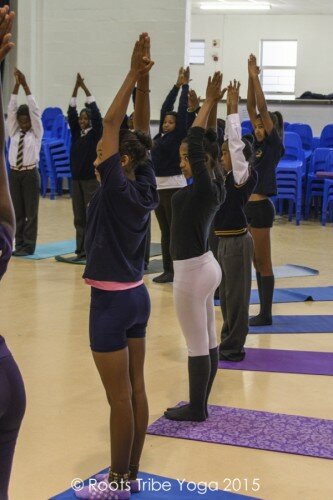 1. Welcome
1. Welcome
We begin (and end) every class in the same way. Over time, this allows the kids to learn that yoga practice is beginning.
2. Warm-up
This includes nearly any activity that gets the kids moving. Warming up is an essential part of yoga, and, when they have a lot of energy, it can be very helpful to have them run around a bit and expend some energy before asking them to sit down and talk.
3. Introduction of Focus
Introduce the focus of the class/week/month. Engage the students by asking what they think about the topic, how it pertains to their everyday lives, how yoga is related/how it can be helpful, for example. It doesn’t need to be long, but set them up with the focus so they begin to see how yoga can relate to various aspects of life.
4. Movement
Get moving! Introduce asanas, familiarize students with a simple sequence, try out new poses that are fun/challenging/silly/calming, or have them make up their own poses and sequences. Anything goes here, as long as it gets them moving and familiarizes them with the basic poses we know and love.
5. Music and Dance
Have fun, do self-expression, teach (or have them teach!) different kinds of dances, play different kinds of music, ask them how the different songs make them feel, have them create their own bands, make music with their bodies, create instruments, teach them different mantras. Have fun, and if you can, get sweaty!
6. Cool Down
After the moving and dancing and sweating, take this time to cool down a bit. You can use traditional asana cool-down poses, or have their dancing slow down with some soothing music; anything to keep them going, slow them down, and prepare for the more settling and grounding portion of class.
7. Going Deeper/Discussion
This is an optional section in which the focus is explored with more depth, and the students have a chance to speak about their own experiences both in the yoga class, and in their lives outside of class.
8. Creativity
Creativity is an important part of RTYoga and depending on how the rest of the class runs, you may want to leave some time for the students to color, create, do expressive movements, or play a creative game.
9. Affirmations
At RTY we strongly believe in the power of Affirmations. We also know that they are accessible and fun to play with, use to create a song, repeat and hear our voices. So be clear on what an affirmation is (and what it is
not—only positive statements, here!) and go to town! It might take a little coaching to get them to understand and to create truly empowered and liberating statements, and that is all right. Be sure to take the time to teach them properly because in doing so, you are also altering their way of thinking about themselves, and what is possible in their lives, in their abilities, and in their futures, and
that is where the magic begins!
“Watch your thoughts, they become words. Watch your words, they become actions. Watch your actions, they become habits. Watch your habits, they become your character. Watch your character, it becomes your destiny.” -Anonymous
10. Breath Work
This can be included at any point in the class and its position within the class structure might also change depending on your focus. There are a number of different breathing techniques that you can use and teach to your students. Be sure to repeat the benefits of the different techniques to them- and eventually use as a fun pop quiz! In some practices, Breath Work is used in place of medicine, so it’s important help them to experience and understand these benefits.
11. Meditation/Svasana
This portion of the class gives the students a chance to process and integrate all that they have done throughout the class time, and I find that they love this practice. Feel it out from day to day to decide what is best for them, but in the long run, do what you can to give them the tools they need to meditate on their own. Imagine if all the world’s children learned how to meditate, what a different kind of world this would turn into as they grew into thoughtful citizens and leaders!
“If every eight-year old in the world is taught meditation, we will eliminate violence from the world within one generation.” -Dalai Lama
12. Optional ‘Om-work’
Om-work is a great way to invite the children to take yoga outside of their yoga class, and to apply it to their everyday lives. The curriculum has Om-work added into each class and you can offer it to them. Remember not to make it obligatory as our goal is to cultivate interest and exploration rather than obligation, imposition, or stress. Have fun with it, casually reward those who complete it, and use it to fuel further discussions.
“Be the change you wish to see in the world.” -Gandhi
 1. Welcome
1. Welcome